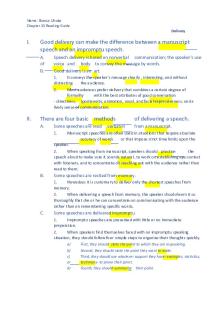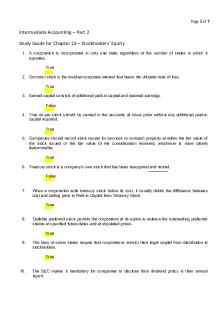Chapter 15 Reading Guide PDF

| Title | Chapter 15 Reading Guide |
|---|---|
| Author | Jonathan Ball |
| Course | Survey of History of Art I |
| Institution | University of Akron |
| Pages | 2 |
| File Size | 89.4 KB |
| File Type | |
| Total Downloads | 94 |
| Total Views | 201 |
Summary
Study Material for the 15th chapter of the Textbook....
Description
7100:100 Art History Survey 1 Dr. Dumser Reading Guide: Chapter 15 Early Medieval Art Covers: Art in Europe from 7th century CE to 11th century CE Terms animal style - Decoration made of interwoven animals or serpents, often found in early medieval Northern European art. carpet page - Carpet pages are a characteristic feature of Insular illuminated manuscripts. They are pages of mainly geometrical ornamentation, which may include repeated animal forms, typically placed at the beginning of each of the four Gospels in Gospel Books. Illumination - A painting on paper or parchment used as an illustration and/or decoration in a manuscript or album. Usually richly colored, often supplemented by gold and other precious materials. The artists are referred to as illuminators. Also: the technique of decorating manuscripts with such paintings. Interlace – interwoven line patterns (inspired by islamic calligraphy) Millefiori - A glassmaking technique in which rods of differently colored glass are fused in a long bundle that is subsequently sliced to produce disks or beads with small-scale, multicolor patterns. The term derives from the Italian for “a thousand flowers.” Parchment - A writing surface made from treated skins of animals. scriptorium (plural: scriptoria) - A room in a monastery for writing or copying manuscripts. Vellum – very fine parchment Westwork - The monumental, west-facing entrance section of a Carolingian, Ottonian, or Romanesque church. The exterior consists of multiple stories between two towers; the interior includes an entrance vestibule, a chapel, and a series of galleries overlooking the nave. Learning Objectives 15.1 List examples of cultural contact and cross-influences between Europe, Northern Italy, the Byzantine Empire, and the Islamic world. Interlace inspired by Islamic calligraphy, animal styles arts influenced by interlace,
15.2 Describe the characteristic objects, subject matter, and appearance of animal style art.
Interlace, jewelry or ornate vessels (boats)
15.3 Using two examples, explain how Christian art and architecture adopts and adapts local styles of art when first emerging in a region. Christians in rome adopt the basilica to a church, romans making gospel images use interlace animal style borders and checkered patterns.
15.4 Using two examples, explain how Carolingian art and architecture looks to Roman art for inspiration. Emotional content and revival of portraiture, sculpture in round not considered idols anymore, bronze
15.5 Describe the key features of Carolingian-Ottonian churches. Westworks, enormously tall masonry entrances to churches that often contain belltowers.
15.6 Note the changing Christian attitude towards sculpture in the church around 1000 CE. Depictions of christ in the round, not viewed as idols.
15.7 Describe attitudes towards artists in early Medieval Europe. Artists are not respected, they are seen as frivolous pursuits that don’t provide any explicit use. Art was a mechanical act, not mental. It was seen as lowly and blue-collar, containing no higher meaning....
Similar Free PDFs

Chapter 15 Reading Guide
- 3 Pages

Chapter 15 Reading Guide
- 2 Pages

Chapter 5 Reading Guide
- 9 Pages

Chapter 8 Reading Guide
- 7 Pages

Chapter 5.1 Reading Guide
- 2 Pages

Chapter 11 Reading Guide
- 2 Pages

Chapter 14 Reading Guide
- 2 Pages

Chapter 13 Reading Guide
- 4 Pages

Chapter 1 Reading Guide
- 3 Pages

Chapter 7 Reading guide
- 9 Pages

Chapter 6 Reading Guide
- 3 Pages

Chapter 11 Reading Guide
- 12 Pages

Chapter 18 Reading Guide
- 4 Pages

Chapter 15 - Study Guide
- 7 Pages
Popular Institutions
- Tinajero National High School - Annex
- Politeknik Caltex Riau
- Yokohama City University
- SGT University
- University of Al-Qadisiyah
- Divine Word College of Vigan
- Techniek College Rotterdam
- Universidade de Santiago
- Universiti Teknologi MARA Cawangan Johor Kampus Pasir Gudang
- Poltekkes Kemenkes Yogyakarta
- Baguio City National High School
- Colegio san marcos
- preparatoria uno
- Centro de Bachillerato Tecnológico Industrial y de Servicios No. 107
- Dalian Maritime University
- Quang Trung Secondary School
- Colegio Tecnológico en Informática
- Corporación Regional de Educación Superior
- Grupo CEDVA
- Dar Al Uloom University
- Centro de Estudios Preuniversitarios de la Universidad Nacional de Ingeniería
- 上智大学
- Aakash International School, Nuna Majara
- San Felipe Neri Catholic School
- Kang Chiao International School - New Taipei City
- Misamis Occidental National High School
- Institución Educativa Escuela Normal Juan Ladrilleros
- Kolehiyo ng Pantukan
- Batanes State College
- Instituto Continental
- Sekolah Menengah Kejuruan Kesehatan Kaltara (Tarakan)
- Colegio de La Inmaculada Concepcion - Cebu

